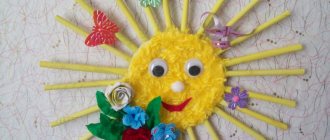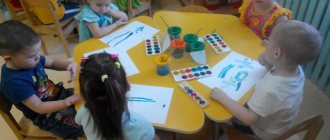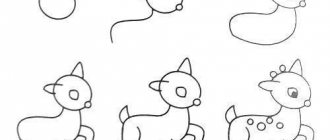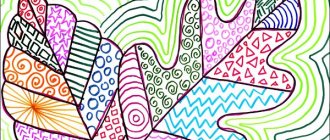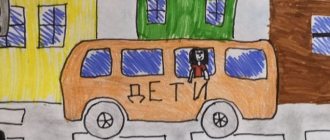Summary of the drawing lesson “Decorate your toys (decorative drawing)”
Lesson notes
“ Decorate your toys
(decorative drawing)”
for children of the general development group, aged 4 to 5 years
Date of:
Educational area:
Artistic and aesthetic development
Class:
Drawing
Priority:
Artistic and aesthetic development is integrated with physical development, social and communicative development, speech development, cognitive development.
Target:
introduce children to the features of Dymkovo painting.
Tasks:
Educational:
— Continue to introduce children to Dymkovo toys, teach them to note their characteristic features, and highlight the elements of the pattern: circles, rings, dots, stripes.
— To strengthen children’s understanding of the bright, elegant, festive colors of toys.
— Reinforce brush painting techniques.
Educational:
— Develop aesthetic perception.
Educational:
— Cultivate accuracy in working with gouache.
Preliminary work:
Acquaintance with Dymkovo products and their painting. Modeling toys.
Forms of work
: Individual, joint activities of the teacher with children, independent activities of children.
Methods:
Verbal:
questions for children, conversation about toys.
Visual
: Dymkovo young ladies, duck, horses, pictures of Dymkovo toys, a sample of a decorated toy
.
Practical:
productive activity.
Types of children's activities
: gaming, communicative, motor, productive.
Individual work
: One toy is drawn on the sheet, draw and paint the second one by analogy.
Materials and equipment:
Demo material
: Dymkovo young ladies, duck, horses, pictures of Dymkovo toys, a sample of a decorated toy
.
Handout:
Landscape sheets, gouache paints, brushes, a jar of water, a napkin (for each child).
Motivation:
invitation to the Dymkovo Toy Museum.
Progress of the lesson:
I. _ Introductory part
Motivational moment:
Educator:
Guys, today I have prepared a surprise for you.
Have you ever been to a museum? ( children's answers
) I invite you to the museum.
Would you like to visit the museum with me? ( children's answers
) Close your eyes (
music sounds
).
Open your eyes. Here we are in the museum ( they go to the table with toys
)
II.
Main part Educator:
Today there is a toy exhibition at the museum.
Look at them, how bright and elegant they are. Can someone tell me what these toys are called? ( children's answers - Dymkovo
) That's right, this is a Dymkovo toy!
Let's, guys, remember the history of this toy. Why were they called that? ( children's answers - because they were made in the village of Dymkovo
) Educator: Why was this village called Dymkovo?
( children's answers
) That's right, because in winter, when the stoves are heated, and in summer, when there is fog, the village seems to be in a haze (
looking at pictures of a village in winter)
Educator:
There is a column of smoke from the chimneys, as if everything is in a haze.
They gave a blue light, and the large village was named “Dymkovo”. People loved songs and dances there, and wonderful fairy tales were born in the village. All toys are not simple, but magically painted. They themselves are snow-white, like birch trees, and they have bright circles, squares, and stripes on them. Educator: Yes, in the old days, in the village of Dymkovo, the Dymkovo toy was born.
What did the craftsmen make it from? ( children's answers - We made this toy from clay)
.
But clay toys don’t look very elegant, so how did Dymkovo ones turn out so cheerful and elegant? ( children's answers - because the Dymkovo masters painted them with bright patterns
) Educator: What elements of painting did the masters use? (children's answers - circles, stripes, dots, grid, ring) Educator: Well done, right. Do you know that there is a secret in these elements: the circle means the sun, the wavy lines mean water, and the intersection of straight lines means the earth. Educator: What colors did the masters use to paint the toy?
(red, yellow, green, blue, orange) Educator: Look, guys, there’s a little duck swimming in the lake. And here are her ducklings. What happened to them, why are they all white and not as bright and beautiful as their mother? What are we going to do? ( children's answers)
I invite you to be a little master of the Dymkovo toy.
Educator: Let's go to our workshop.
Physical education minute . The ducks came out into the meadow, quack-quack-quack! (We walk.) A cheerful beetle flew by, J-z-z! (We wave our arms like wings.) The geese arch their necks, Ha-ha-ha! (Circular rotation of the neck.) The feathers are straightened with the beak. (Turns the body left and right.) The reeds whispered in the water, Shhhh! (They raised their hands up and stretched.) And again there was silence, Sh-sh-sh.
Educator: Look, guys, in our workshop we have everything to turn an ordinary figurine into a real painted Dymkovo toy.
You and I will paint our ducks with Dymkovo patterns. Let's look at the patterns on our duck ( look at the patterns on the duck)
Educator: A duck is a favorite image in folk art associated with the sun and abundance.
The chest and wings of the bird are decorated with patterns reminiscent of a large and small sun. Duck-Marfutka is walking along the shore, Duck-Marfutka is leading him to swim. Educator. Look how I decorated my duck. Guys, remember how to work when painting. Before picking up another paint, you need to rinse the brush, and only then take another paint. Now we draw dots with the tip of the brush. We draw the stripes by placing the brush on the paper and moving it from left to right. And now I propose to take your jobs. See what's ready for work. We remember how we use a napkin, how we remove excess paint, and rinse the brush. ( Work done by children
) Educator: Guys, you are real folk craftsmen, you did a good job.
Children look at the painted ducklings and express their opinions.
Children close their eyes, music sounds.
III. Final part
Educator:
Here we are again in kindergarten.
- Guys, where have we been?
– Whom did we describe?
— Did everything work out for you or did you have difficulties?
Abstract of GCD for drawing “Funny Toys”
Summary of GCD for drawing (drawing along the contour) “Magic toys”
Target:
Develop the ability to trace objects along a contour, starting from a given point.
Tasks:
Educational:
—
Learn to trace objects along a contour, starting from a given point.
—
Continue to learn how to hold a pencil correctly.
- Continue working with four primary colors - red, yellow, green, blue.
Developmental:
Develop attention, visual and motor coordination, fine motor skills.
Educating:
Cultivate an interest in drawing with colored pencils.
Materials and equipment:
Coloring pages with a simple outline of toys, colored pencils, examples of work. Table theater, theater screen.
Nod's move.
Educator:
Hello guys. Do you love fairy tales?
Today I will tell you a fairy tale. Listen.
In one fairy-tale kingdom there lived a King - Pencil. He loved toys very much, and he also loved to walk the streets of his kingdom and distributed pencils to the residents so that they could decorate the walls of their houses with drawings of toys, and also draw pictures. And then he organized holidays, where all the residents had fun and gave each other their works. The residents loved their king very much and gladly accepted gifts from him and drew, painted, painted. And nowhere in the world was there a kingdom more beautiful, brighter, more wonderful and kinder than the kingdom of the King - Pencil.
One day, an evil Sorcerer was jealous of Pencil that his kingdom was very beautiful and made all the residents’ pencils disappear. They could no longer paint their pictures. They had nothing.
The Pencil King became sad and fell ill. The best doctors in the kingdom could not cure him...
Slowly the kingdom lost its bright color and drawings - the toys turned into dots. Even the sun seemed to be shining less, and there were more and more cloudy days.
On one of these cloudy days, one Fairy appeared in the kingdom. She was just flying by. The residents told her about their misfortune.
“Your king will recover if you start drawing pictures again,” said the Fairy.
The residents were surprised and began to think about what they should use to draw, but they couldn’t come up with anything.
Then the fairy offered to defeat the evil sorcerer and return the pencils.
Hooray! - the residents exclaimed. And everyone went to the evil sorcerer. And they didn’t go on foot, but flew by plane.
Physical education minute. Airplane
Hands to the sides - take flight
We're sending the plane
Right wing forward
Left wing forward.
One two three four -
Our plane took off. (Stand legs apart, arms to the sides, turn to the right; turn to the left.)
Sat down - stood up, sat down - stood up
GCD summary. “Dymkovo young lady” (decorative drawing). Middle group.
Municipal budgetary preschool educational institution "Kindergarten "Rainbow"
With. Svyatoslavka, Samoilovsky district, Saratov region
ABSTRACT
Direct educational activities
On the topic: “Dymkovo young lady” (decorative drawing)
(middle group)
Educator: Belyanskaya E.A.
2016
Sample general education program “Childhood”
Age group – middle
GCD theme : “Dymkovo young lady” (decorative drawing)
Goal : Painting silhouettes of Dymkovo toys.
Tasks:
- Introduce children to the Dymkovo toy.
- Show options for combining decorative elements by color and shape (dots, circles, straight lines, lattice)
- Develop imagination and color perception.
- Teach children to emotionally perceive the upcoming work, develop a desire to draw.
Preparatory work:
Decorative drawing “Let’s decorate the apron” “Beautiful plate” “Napkin for mom”
Demonstration material : Images of Dymkovo dolls.
Handout : silhouette of a Dymkovo doll, gouache paints, brush, napkins, cotton swabs, sippy cup with water.
GCD move.
- Introductory part.
The Dymkovo young lady walks slowly. Everyone admires her, oh, how pretty!
Educator: Children, look, today very unusual dolls in beautiful outfits came to visit us. They came to us from afar. From the village of Dymkovo. In this village, all the people are engaged in making toys like these dolls and other toys of animals and birds. And these toys are called Dymkovo toys. These toys are made from clay, but the clay is brown and not beautiful. And to make the toys beautiful, they are then painted with different colors.
Let's look at the painted dolls. They are so elegant, like young ladies.
Educator: Children, what are the Dymkovo young ladies wearing? Children: Skirt, jacket. Educator: What does the young lady have on her head? Children: Hat.
Educator: This young lady really has a hat, and this one has a kokoshnik. Beautiful women's headdress.
Educator: What colors did the masters use to paint toys?
Children: Red, orange, blue, light blue, green, yellow, crimson.
Educator: Today I invite you to become Dymkovo masters, do you want to?
Children: Yes!
Educator: Like real masters, you will paint the outfits of Dymkovo dolls.
Educator: Let’s start painting from the head, from the kokoshnik, otherwise we’ll smear the drawing with our hands.
Where should we start painting?
Children: From the head, from the kokoshnik.
Educator: Look at the Dymkovo dolls again! Tell me, what is painted in one color, and what is painted with patterns?
Children: The kokoshnik and blouse are painted the same color, and the skirt is patterned.
- Part. Main.
Educator: (I attach the silhouette of a doll drawn on a piece of paper to the easel, show and explain to the children the sequence of work) Guys, first, use the end of the brush to paint over the kokoshnik and try not to stain the doll’s face. Then paint over the young lady’s blouse, look, I’m leaving white hands on the doll. And only then do we start decorating the skirt. You can draw a pattern on the skirt, whatever you want: striped, checkered or with rings (I show three options for painting a skirt: striped skirt, checkered, rings)
Educator: Each master paints a toy according to his own taste, so they are not similar to one another, but each is beautiful in its own way. You will portray the doll as you wish. I suggest you think, before you start working, what paints you want to use and what pattern you will paint your doll with. If someone finds it difficult, then there are images of dolls on the board to help you.
For painting, I have prepared paints, brushes and cotton swabs for you. What are the brushes for? What are cotton swabs for?
(children's answers)
Now let’s go to the workshop and decorate the outfits of the Dymkovo young ladies.
The children take their seats and get to work.
Educator: Try to keep your work neat, do not take a lot of paint, soak excess water from the brush on a napkin.
- Part. Final.
Educator: Now, look at your dolls. How beautiful they are! Do you like your work?
Children: Yes!
Educator: Our toys lit up and became beloved. Indeed, you can’t stop looking at them! Even my soul felt joyful.
All toys are not simple,
And magically painted.
Snow-white, like birches,
Circles, squares, stripes.
A seemingly simple pattern
But I can’t look away.
Educator: Well done, guys. Today in class you visited the Dymkovo masters, learned how to paint toys and did a very good job.
Summary of a lesson in fine arts (drawing) in the middle group “Dress for a doll”
Zastavina Tatyana Ustinovna
MBDOU "Kindergarten No. 7 "Semitsvetik" Guryevsk
Educator
Summary of a lesson in fine arts (drawing) in the middle group “Dress for a doll”
Software tasks:
1. Teach children how to decorate for Katya’s doll
2. Continue teaching children to hold the brush correctly, dip the entire bristles into the paint, and remove the excess drop on the edge of the jar. 3. Develop fine and gross motor skills. Develop visual attention and the ability to visually coordinate your movements. Continue learning to differentiate primary colors. To develop the ability to imitate an adult, finishing words and phrases, to promote speech activation.
4. Introduce children to the type of decorative and applied art “Dymkovo painting” Preliminary work:
Didactic game “Pick a dress for the doll”, conversation on the topic: “What kind of clothes are there?” Looking at illustrations depicting different dresses. Material:
- silhouettes of dresses, gouache (yellow, red, blue) - Brushes No. 5, jars of water, stands for brushes. - Napkins. - toy (doll) Lesson progress.
Part 1
: Preliminary work: Educator:
Guys, we received a telegram from the Katya doll. She writes that today is her birthday. Katya wanted to come to visit us, but on the way she soiled her dress. She was very upset and did not come to us. How can you and I help Katya?
Children: Draw her a new dress!
- That's right, let's help the doll, draw her a new dress so that she can come to visit us. Part 2:
Main part: - Look at my easel, I got these dresses. What's on them? - (children's answers) - Stripes and dots are correct. — Stripes, what color? - (children's answers) - What color are the dots? - (children's answers)
You know, there is a type of decorative and applied art that uses bright colorful patterns - horizontal and vertical lines, patterns - cells, large and small circles, suns. This type of decorative and applied art is called “Dymkovo painting.” And today we will be real artists and decorate Katya’s dress with Dymkovo painting ornaments.
- Now look at how to draw a pattern on a dress. You all have dresses on the table. First watch how I will draw. — I take the brush by the iron skirt, wet it in water, then pick up red paint, remove excess paint on the edge of the can. And I draw a line from top to bottom, without lifting the brush from the dress. Then I draw a second line as well as a third. I rinse the brush in a jar. I take blue paint on the brush, step back a little from the top and draw a line from left to right, without lifting the brush from the dress. I step back a little and draw another blue line from left to right, without lifting the brush from the dress, and another blue line. I rinse the brush in a jar. Now I dip the brush into yellow paint and make dots in the windows (in the middle).
